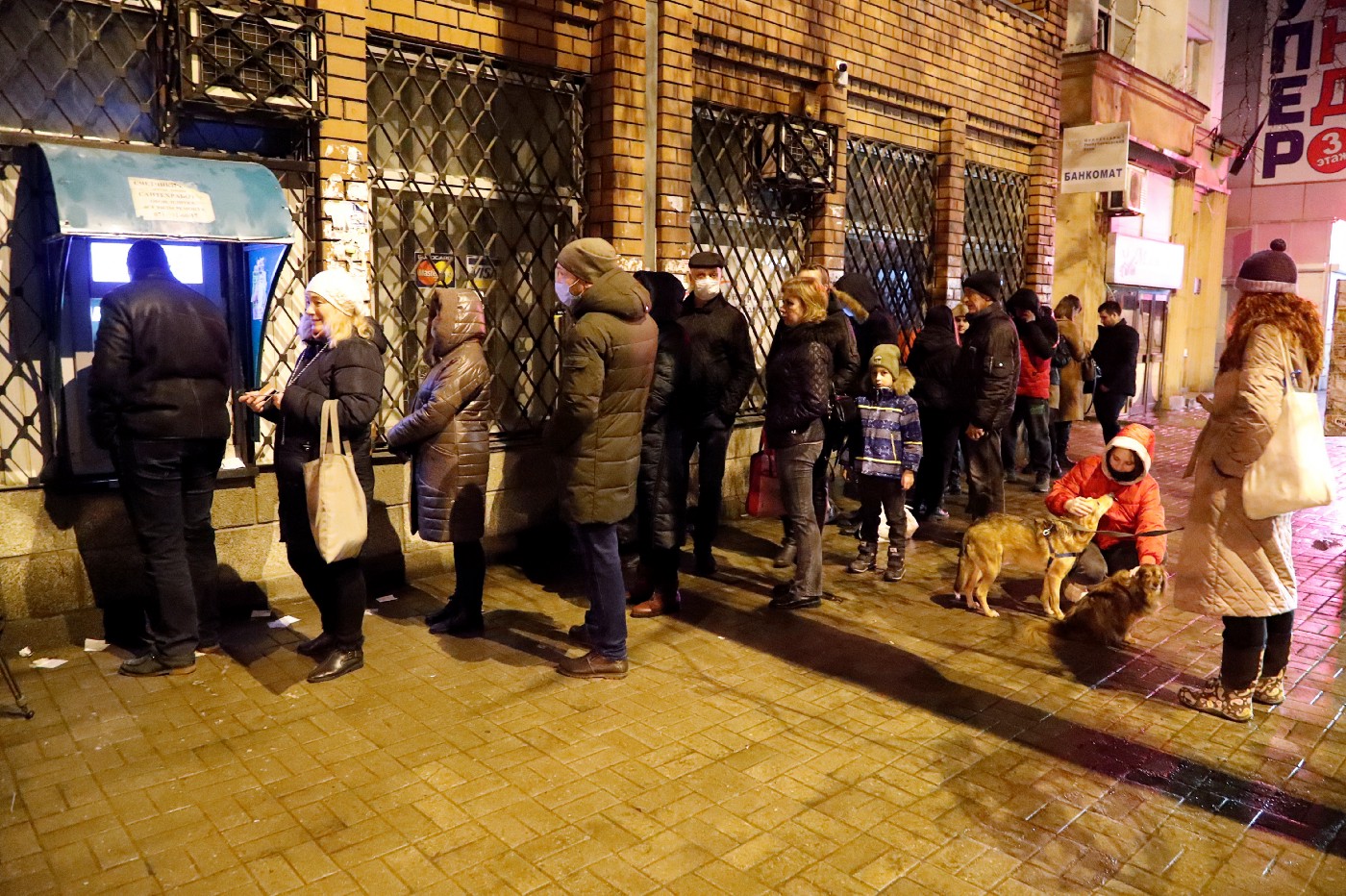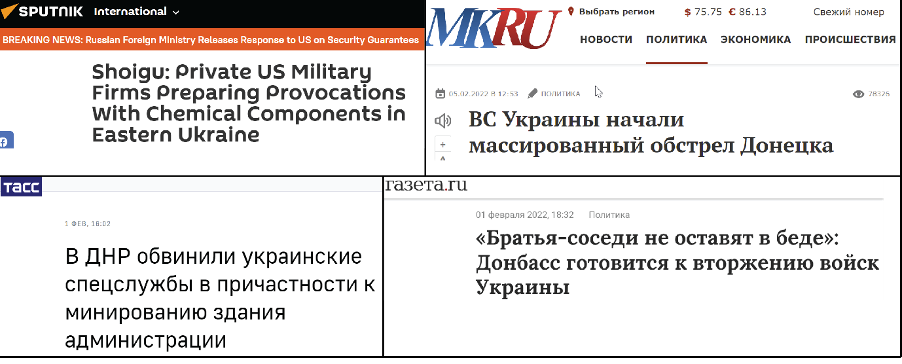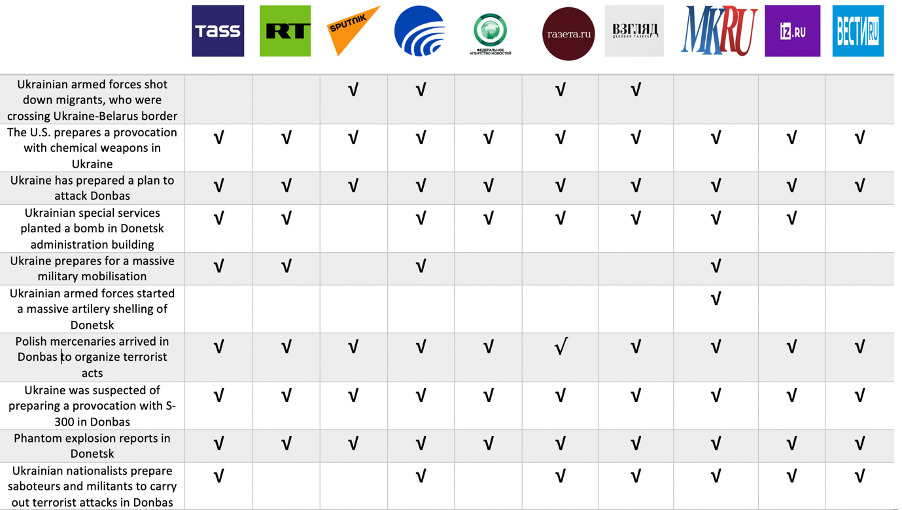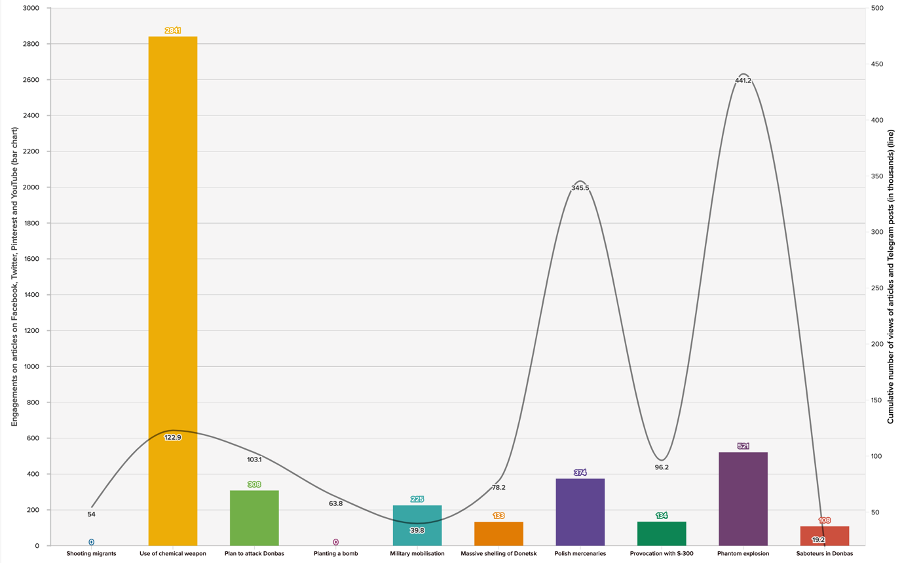How ten false flag narratives were promoted by pro-Kremlin media
Russian media actively portrays the self-proclaimed Donetsk and Luhansk People’s Republics as victims of Ukrainian aggression.
How ten false flag narratives were promoted by pro-Kremlin media
Share this story

BANNER: Residents of Donetsk line up at an ATM machine after receiving evacuation orders on February 18, 2022. (Source: REUTERS/Alexander Ermochenko)
Amid Russia’s ongoing military buildup around Ukraine’s borders, Kremlin-controlled and pro-Kremlin media outlets in Russia relentlessly amplify false or misleading narratives about Ukrainian aggression against the self-proclaimed Donetsk and Luhansk People’s Republics (DNR and LNR) in Eastern Ukraine. These ongoing efforts accusing Ukraine of threatening the lives of people in Ukraine’s breakaway regions could serve as pretext by Russia to invade the country.
The DFRLab analyzed ten false and misleading narratives, mainly coming from Russia-led separatist leaders in Eastern Ukraine, that were widely amplified by Russian media outlets. Each of these narratives accused Ukraine of being the aggressor in the conflict. Notably, Kremlin media outlets have intensified pushing false-flag narratives since early February 2022.
Russia previously used a false-flag operation as pretext to invade Ukraine in 2014, when Russian special forces sent unmarked soldiers to seize government buildings, leading to the annexation of Crimea and the occupation of Eastern Ukraine. These Russian soldiers pretended to be local self-defense forces; the Kremlin still denies its involvement in the conflict.
US officials have warned since early February 2022 that Russia could use false-flag operations as justification to invade Ukraine, but the Kremlin keeps issuing denials. The DFRLab’s analysis of recent false-flag narratives between December 1, 2021 and February 14, 2022 indicates that pro-Kremlin media actively promote these narratives, potentially laying the groundwork to justify Russian military action.
While these ten false-flag narratives are representative of the many rumors and conspiracy theories published by pro-Kremlin media to paint Ukraine as the aggressor, it should be noted that they are by no means exhaustive, as new false-flag narratives now appear on a nearly daily basis. On the day of publishing, for example, the leaders of the breakaway republics announced they were evacuating civilians into Russia after making unsupported claims that saboteurs had attempted to detonate chlorine tanks. This was then followed by a car bombing in Donetsk, which local authorities quickly claimed was an assassination attempt against a government official.

Narrative: Ukrainian border guards shoot migrants from Belarus (December 1, 2021)
A video appeared on several private Facebook pages showing thermal imaging of five armed individuals gunning down around 20 people. Commenters claimed that the footage depicted Ukrainian border forces shooting refugees fleeing from Belarus. One account even claimed that Ukrainian President Volodymyr Zelenskyy issued the command himself because he had received an order from “abroad.” These reports also alleged the video had been leaked by Rinat Akhmetov, a Ukrainian oligarch that Zelenskyy and Western officials believe is a potential candidate to replace him in a puppet regime if Russia initiated a successful coup against the Ukrainian government.
Meanwhile, local media in the city of Zhytomyr reported there had been a shooting incident but later deleted the story, reporting that their website had been hacked. Meanwhile, a local NGO, Detector Media, also had a Web page edited illicitly claiming that the oligarch was behind the video. The webpage was deleted by the organization soon after being spotted. However, these reports were picked up by pro-Kremlin media and an anonymous Telegram channel.
The Ukrainian Centre for Strategic Communications analyzed the footage of the incident, ultimately debunking it.
Narrative: US mercenaries preparing biochemical weapons in Ukraine (December 21, 2021)
Russia Defense Minister Sergei Shoigu claimed that US private military firms were preparing biochemical components to provoke fighting in Eastern Ukraine. On Russian state TV, Eduard Basurin, deputy chief of the DNR Militia Directorate, went further and even identified the biochemical in question as Botulinum toxin. DNR leader Denis Pushilin stated that Donetsk’s water supply would be poisoned.
Pentagon Press Secretary John F. Kirby denied the allegations during a press briefing that same day. “Those statements by Minister Shoygu are completely false,” he said. Ukrainian Ministry of Foreign Affairs spokesperson Oleg Nikolenko also denied the allegations and stated that such messages are simply the latest examples of Russian disinformation campaigns.
Narrative: Ukraine has prepared a plan for attacking Donbas (February 1, 2022)
DNR Militia Deputy Chief Eduard Basurin claimed that the General Staff of the Armed Forces of Ukraine had completed its plan to invade the Donbas. He asserted that the plan would be presented by the leadership of the Armed Forces of Ukraine, then sent for approval by the National Security and Defense Council. LNR separatist leaders claimed Ukraine was preparing to invade and noted that if Ukraine attacked the Donbas, Russia would immediately need to protect more than 700,000 Russian citizens living there.
Ukrainian officials have repeatedly underlined that Ukraine does not intend to undertake any military operation against the Donbas, and that Kyiv is committed to finding a diplomatic and political solution to the conflict. Nonetheless, the Kremlin continues to cite Ukraine’s “military aggression against the Donbas” as pretext for its military build-up near Ukraine.
Narrative: Ukrainian special services planted a bomb in a Donetsk administrative building (February 1, 2022)
The DNR Defense Ministry reported that security services prevented a terrorist act by Ukrainian special forces to bomb a Donetsk administrative building. An anonymous message about the setting of explosives was allegedly sent to city administrators by e-mail. Moskovskij Komsomolets wrote that a bomb found in the building consisted of TNT and four electronic detonators, while Regnum claimed that Ukrainian terrorists previously staged a series of explosions in the Donbas to kill local military and political leaders. Despite these allegations, the separatist regimes failed to provide any evidence that a bomb had been found, or that Ukraine was behind it.
Narrative: Ukraine prepares for a massive military mobilization (February 3, 2022)
Kremlin-owned media claimed that Ukraine would prevent men of conscription age from leaving the country. They also reported that enlistment offices would prepare lists of citizens subject to mobilization, implying that such a decision might soon occur. While a limitation of movement would violate Ukrainian law, this narrative likely emerged to create panic among the civilian population. The Ukrainian government’s Center for Strategic Communication debunked the claim, calling it a provocation. Ukraine’s defense minister stated in an interview that there would be no conscription mobilization, and that Ukraine would instead rely on existing territorial defense forces.
Narrative: Ukrainian armed forces initiated a massive artillery attack on Donetsk (February 5, 2022)
Pro-Kremlin media outlet Moskovskiy Komsomolets reported that Ukrainian forces had initiated a massive shelling of Donetsk, including artillery, mortars, and even grenade launchers. The source of the report came from a Telegram channel, Novorossiya Militia Reports (Сводки Oполчения Новороссии), which wrote on February 5 that Ukrainian armed forces opened artillery fire on the northern part of Donetsk. Novorossiya’s website also claimed that residents of Donetsk had woken up to the sound of Ukrainian artillery bombardment. The post included a photo of what appeared to be clouds of smoke on the horizon, but the source of the smoke was not depicted.
The OSCE Special Monitoring Mission to Ukraine recorded 38 explosions in the Donetsk region between the evenings of February 4–6, 2022, but these explosions were not attributed to either side of the conflict. A Polygraph.info fact-check argued that it was suspicious that either side could have conducted a “massive artillery” bombardment, as only 38 explosions were reported in Donetsk region over a 48-hour period.
Narrative: Polish mercenaries arrive in Donbas to organize terrorist acts (February 7, 2022)
Leaders of the Ukrainian breakaway regions of Donetsk and Luhansk pushed claims about the arrival of Polish mercenaries in eastern Ukraine. On February 7, the DNR asserted that two groups of Polish mercenaries had appeared in Ukraine-controlled areas of the Donbas. They alleged the mercenaries were working with Ukrainian forces to conduct terrorist acts and sabotage the self-proclaimed republics. DNR leaders also claimed that Polish mercenaries would try to damage civilian infrastructure in the region to trigger a response from DNR military units, thus completing their objective of pushing the Donbas region into a war. The Telegram channel Donbas Decides alleged that Polish mercenaries were instructing Ukrainian forces how to kill Donbas civilians. Previously, LNR separatist leaders had claimed that mercenaries from the US private military company Academi (formerly Blackwater) were present in the Donbas.
The Ukrainian Center for Strategic Communications and Information Security promptly denied the presence of foreign mercenaries on Ukrainian territory. It stated that representatives of NATO countries are invited to Ukraine as instructors only, adding that only Ukrainian forces are “fighting for Ukraine.”
Narrative: Ukraine deployed S-300 anti-aircraft missiles near the Donbas (February 11, 2022)
The DNR’s Eduard Basurin claimed that Ukraine had deployed S-300 anti-aircraft missile systems to Kramatorsk, near the current front line. Multiple Russian media amplified the message, with some adding that such systems could be dangerous for Russian passenger aircraft near the border, rehashing the widely debunked claim that Ukraine shot down the MH-17 jetliner rather than Russia.
Similar to previous allegations, the DNR did not provide evidence to back up their claims. The DFRLab could not find evidence to disprove the allegations, as defensive military deployments of anti-aircraft systems might have occurred in light of a possible Russian invasion. Meanwhile, Russia was spotted moving its own S-300 air-defense systems to the Ukrainian border through Kursk.
Narrative: a phantom explosion in Donetsk (February 12, 2022)
RT cited unnamed local media sources to report a February 12 explosion in Donetsk. A few minutes after this message, Ukrainian pro-Russian media Strana UA published a screenshot of online commenters discussing an explosion near Donetsk airport. Citing DNR chief Denis Pushilin, RT editor-in-chief Margarita Simonyan then confirmed the explosion had taken place on the Ukraine side of the conflict line, but added that RT correspondents in Donetsk did not hear any explosions. RT also published a comment by the DNR’s Eduard Basurin, who claimed that he did not hear anything either. Some time later, Simonyan forwarded yet another message, now claiming the whole thing was “Ukrainian disinformation.” Meanwhile, Pushilin contended that the situation was under control and that the explosion in Ukraine-controlled territory might have been “the filming of a provocation” against the DNR, in line with previous claims by DNR and LNR leaders.
The Ukrainian Joint Forces published a statement that Ukrainian troops were following the ceasefire and did not conduct any shelling. RT had somehow simultaneously confirmed and debunked the incident.
Narrative: Ukrainian nationalists prepare saboteurs and militants to carry out terrorist attacks in Donbas (February 14, 2022)
The LNR claimed that Ukraine had created a secret network of saboteurs in order to carry out terrorist acts and sabotage at infrastructure facilities in the Donbas region, in cooperation with Ukrainian security services. LNR military spokesman Ivan Filiponenko claimed that Ukrainian militants arrived in the Donbas and expelled local residents from their houses, and that civilians had appealed to local authorities with complaints of atrocities committed by Ukrainian “radicals.” He also asserted that Ukrainian saboteurs were being trained by Polish and Canadian instructors. Filiponenko provided no evidence to support his claims.
How false-flag narratives were widely amplified by Russian media outlets
The DFRLab selected ten Kremlin-controlled and pro-Kremlin Russian media outlets and examined how many of them covered the above false-flag narratives. At least six of the narratives had been covered by all ten outlets.

The DFRLab also examined cumulative views of articles pushing these false-flag narratives on the ten outlets’ websites and Telegram channels. Articles about the so-called phantom explosion in Donetsk were viewed over 440,000 times, followed by articles about Polish mercenaries, which garnered over 345,000 views across the outlets’ websites and Telegram. When it comes to audience engagement, stories about US mercenaries deploying biochemical weapons garnered over 2,800 engagements across different platforms, followed by stories about the phantom explosion in Donetsk, which accumulated more than 520 engagements.

The DFRLab analysis demonstrates how Russian media outlets actively reinforce current tensions by posting false or misleading claims of Ukrainian aggression. Though the Kremlin denies having any intention of invading Ukraine, the situation on the ground and across the pro-Kremlin media landscape indicates that Russia continues to develop potential pretexts for doing just that.
Cite this case study:
Givi Gigitashvili and Roman Osadchuk, “How ten false flag narratives were promoted by pro-Kremlin media,” Digital Forensic Research Lab (DFRLab), February 18, 2022, https://medium.com/dfrlab/how-ten-false-flag-narratives-were-promoted-by-pro-kremlin-media-c67e786c6085.

